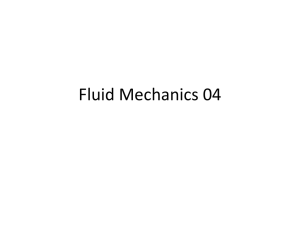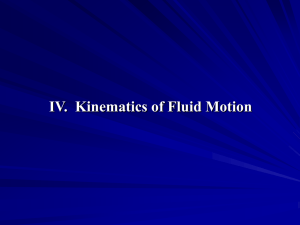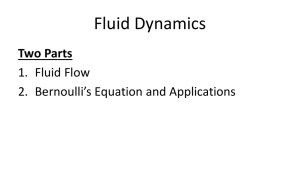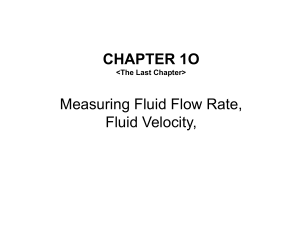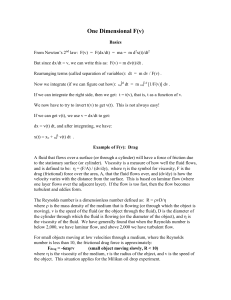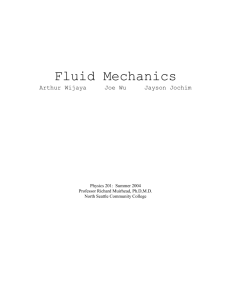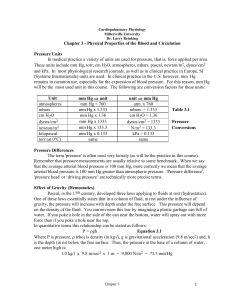Lecture03 - Lcgui.net
advertisement
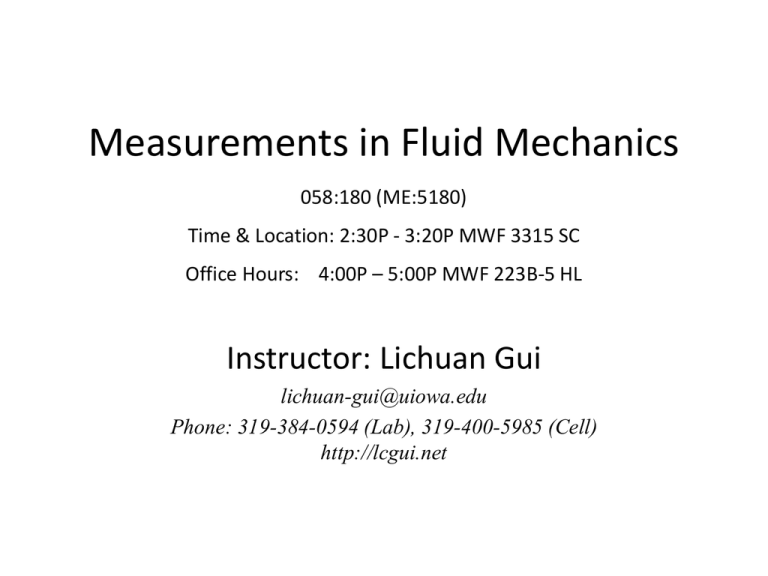
Measurements in Fluid Mechanics 058:180 (ME:5180) Time & Location: 2:30P - 3:20P MWF 3315 SC Office Hours: 4:00P – 5:00P MWF 223B-5 HL Instructor: Lichuan Gui lichuan-gui@uiowa.edu Phone: 319-384-0594 (Lab), 319-400-5985 (Cell) http://lcgui.net Lecture 3. Similarity and flow motion patterns 2 Similarity and non-dimensionalization Different ways to perform measurement: 1. Actual system under actual operation condition - expensive and impossible in most cases 2. Actual system under modified condition - expensive and impossible in many cases 3. Model system under controlled condition - low cost and possible Similarity - enable application of measured properties with model system and modified condition to actual system under actual condition. Requirements of similarity 1. Geometrically similar - same shape, the same ratios of all corresponding dimensions 2. Kinematically similar - same velocity directions and constant ratio of magnitudes 3. Dynamically similar - same force directions and constant ratio of magnitudes Non-dimensionalization - convert measured properties into dimensionless numbers 1. Convenience in presentation 2. Independent of unit system 3. Used as guide for selection of optimal geometrical and operating conditions 3 Similarity and non-dimensionalization Navier Stokes equations - viscous incompressible flows 𝐷𝑈𝑖 1 𝜕𝑝 𝜕 2 𝑈𝑖 𝜕 2 𝑈𝑖 𝜕 2 𝑈𝑖 = 𝑔𝑖 − +𝜈 + + 𝐷𝑡 𝜌 𝜕𝑥𝑖 𝜕𝑥1 2 𝜕𝑥2 2 𝜕𝑥3 2 𝑖 = 1,2,3 - Characteristic properties L – length scale V0 – velocity scale - Dimensionless variables 𝑥𝑖 𝑝 ∗ ∗ 𝑥𝑖 = 𝑝 = 𝐿 𝑝0 p0 – reference pressure 𝑉0 𝑡 𝑈𝑖 ∗ 𝑡 = 𝑈𝑖 = 𝐿 𝑉0 𝜕 2 𝑉0 𝑈𝑖 ∗ 𝜕 2 𝑉0 𝑈𝑖 ∗ 𝜕 2 𝑉0 𝑈𝑖 ∗ +𝜈 + + 𝜕 𝐿𝑥1 ∗ 2 𝜕 𝐿𝑥2 ∗ 2 𝜕 𝐿𝑥3 ∗ 2 𝑔𝑖 ∗ = 𝐷 𝑉0 𝑈𝑖 ∗ 1 𝜕 𝑝∗ 𝑝0 ∗ = 𝑔𝑔𝑖 − 𝐷 𝐿𝑡/𝑉0 𝜌 𝜕 𝐿𝑥𝑖 ∗ 𝑔𝑖 𝑔 g – gravitational acceleration magnitude ∗ 𝑉0 2 𝐷𝑈𝑖 ∗ 𝑝0 𝜕𝑝∗ 𝜈𝑉0 𝜕 2 𝑈𝑖 ∗ 𝜕 2 𝑈𝑖 ∗ 𝜕 2 𝑈𝑖 ∗ ∗ = 𝑔𝑔𝑖 − + + + 𝐿 𝐷𝑡 ∗ 𝜌𝐿 𝜕𝑥𝑖 ∗ 𝐿2 𝜕𝑥1 ∗ 2 𝜕𝑥2 ∗ 2 𝜕𝑥3 ∗ 2 𝐷𝑈𝑖 ∗ 𝑔𝐿 ∗ 𝑝0 𝜕𝑝∗ 𝜈 𝜕 2 𝑈𝑖 ∗ 𝜕 2 𝑈𝑖 ∗ 𝜕 2 𝑈𝑖 ∗ = 2 𝑔𝑖 − + + + 𝐷𝑡 ∗ 𝑉0 𝜌𝑉0 2 𝜕𝑥𝑖 ∗ 𝑉0 𝐿 𝜕𝑥1 ∗ 2 𝜕𝑥2 ∗ 2 𝜕𝑥3 ∗ 2 - Non-dimensinlized Navier-Stokes equations 𝐷𝑈𝑖 ∗ 1 ∗ 1 𝜕𝑝∗ 1 𝜕 2 𝑈𝑖 ∗ 𝜕 2 𝑈𝑖 ∗ 𝜕 2 𝑈𝑖 ∗ = 2 𝑔𝑖 − 𝐶𝑝 2+ 2+ ∗+𝑅 ∗ ∗ 𝐷𝑡 ∗ 2 𝜕𝑥 𝜕𝑥 𝜕𝑥 𝜕𝑥3 ∗ 2 𝐹𝑟 𝑖 𝑒 1 2 4 Common dimensionless parameters Reynolds number - ratio of inertia forces to viscous forces 𝑅𝑒 = 𝜌𝑉𝐿 𝑉𝐿 = 𝜇 𝜈 V – characteristic velocity – kinematic viscosity L – characteristic length – dynamic viscosity ( = ) Mach number - used to describe effects of compressibility 𝑉 V – flow velocity c – speed of sound 𝑀= 𝑐 Euler number (pressure coefficient) - ratio of pressure and inertia forces 𝑝 − 𝑝𝑟𝑒𝑓 p – pressure pref – reference pressure 𝐶𝑝 (≡ 𝐸𝑢) = 1 2 – density V – flow velocity 2 𝜌𝑉 Drag coefficient - ratio of drag force and inertia forces 𝐶𝐷 = 𝐹𝐷 1 2 2 𝜌𝐴𝑉 FD – drag force A – frontal area – density V – flow velocity Lift coefficient - ratio of lift force and inertia forces 𝐶𝐿 = 𝐹𝐿 1 2 𝜌𝐴𝑉 2 FL – lift force A – frontal area – density V – flow velocity 5 Common dimensionless parameters Prandtl number - ratio of rates of diffusion of momentum and heat due to molecular motions 𝜈 𝑐𝑝 𝜇 𝑃𝑟 = = 𝛾 𝑘 – thermal diffusivity – kinematic viscosity cp – specific heat under contant pressure – dynamic viscosity k – thermal conductivity Schmidt number - ratio of rates of diffusion of momentum and mass in fluid 𝜈 𝑆𝑐 = c – molecular diffusivity of a fluid mixture of species in a fluid mixture 𝛾𝑐 Froude number - square represents ratio of inertia to gravitational forces (free surface flows) 𝑉 V – flow velocity L – characteristic length 𝐹𝑟 = 𝑔𝐿 g – gravitational acceleration magnitude Weber number 𝜌𝑉 2 𝐿 𝑊𝑒 = 𝜎 - ratio of inertia to surface-tension forces – surface tension – density V – flow velocity L – characteristic length Capillary number - ratio of viscos forces to surface-tension forces 𝜇𝑉 𝐶𝑎 = 𝜎 – dynamic viscosity V – flow velocity – surface tension 6 Common dimensionless parameters Cavitation number 𝑝 − 𝑝𝑣 Pv – vapour pressure 𝜎𝑐 = 1 2 2 𝜌𝑉 Nusselt number - ratio of total and conductive heat transfer rates in a fluid ℎ𝐿 𝑁𝑢 = 𝑘 Biot number 𝐵𝑖 = h – overall heat transfer coefficient k – thermal conductivity of fluid - ratio of heat transfer rates to surrounding fluid and solid interior ℎ𝐿 𝑘 Peclet number h – overall heat transfer coefficient k – thermal conductivity of solid - ratio of heat convection and heat conduction 𝑉𝐿 𝑃𝑒 = = 𝑅𝑒 𝑃𝑟 𝛾 Grashof number 𝛼𝑔𝐿3 ∆𝑇 𝐺𝑟 = 𝜈2 V – flow velocity L – characteristic length – thermal diffusivity - ratio of buoyancy forces and viscous forces – thermal expansion coefficient T – temperature difference 7 Common dimensionless parameters Rayleigh number - for free thermal convection 𝛼𝑔𝐿3 ∆𝑇 𝑅𝑎 = = 𝐺𝑟 𝑃𝑟 𝜈𝛾 Marangoni number - for convection induced by surface-tension gradients 𝜕𝜎 𝜕𝑐 2 𝐿 𝜕𝑐 𝜕𝑥 𝑀𝑎 = 𝜇𝛾𝑐 𝜕𝜎 𝜕𝑇 2 𝐿 𝜕𝑇 𝜕𝑥 𝑀𝑎 = 𝜇𝛾 Richardson number 𝑔𝑝 𝑅𝑖 = − 𝑧 𝑉 𝜌 𝑧 2 - for concentration gradients - for temperature gradients - for density-stratified flows 1 𝑔𝑧 −2 = − 2 = −𝐹𝑟 𝑉 - ratio of potential energy associate with gravity and kinetic energy. 8 Common dimensionless parameters - for rotation flows Taylor number Ω2 𝐿4 𝑇𝑎 = 2 𝜈 – rotation rate - for rotation flows Rossby number 𝑅𝑜 = 𝑉 𝐿 - ratio of inertia and Coriolis forces Strouhal number - for periodic vortex shedding from bluff objects 𝑆= 𝑓𝐿 𝑉 f – frequency of vortex shedding Knudsen number - for gas 𝜆 𝐾𝑛 = 𝐿 – mean free path 9 Patterns of fluid motion Pathlines - trajectories of individual fluid particles - may be visualized with multiple exposed particle images Stroboscopic illumination of oil drop in laminar pipe flow 10 Patterns of fluid motion Timelines - each formed by a set of fluid particles at a previous instant in time, and displaced in time as the particles move - may be visualized with Hydrogen-bubble technique Consecutive rows of hydrogen bubbles indicating Velocity profiles a flat plat boundary layer 11 Patterns of fluid motion Streaklines - each formed by locus of all fluid particles passing through a fixed position - may be visualized with dye lines in water flow Vortex flow behind a yawed cylinder visualized with mixture of ink, milk and alcohol 12 Patterns of fluid motion Streamlines - instantaneous curves tangent to the velocity vector of flow, i.e. - may be visualized with smoke lines in stead air flow 𝑑𝑥1 𝑑𝑥2 𝑑𝑥3 = = 𝑈1 𝑈2 𝑈3 - may be visualized with tuft screen method Smoke lines around an airfoil model in a wind-tunnel Trailing vortices behind an inclined delta-wing visualized by a tuft screen 13 Patterns of fluid motion In steady flows, pathlines, streaklines and streamlines coincide. In unsteady flows, they may be vastly different. Red – Pathline Blue – Streakline Dash – Sreamline 14 Homework - Read textbook 1.6-1.7 on page 11-17 - Questions and Problems: one of 10, 14 on page 17 and 18 - Due on Wednesday, 08/29 - Send MS Word or PDF file to lichuan-gui@uiowa.edu 15


